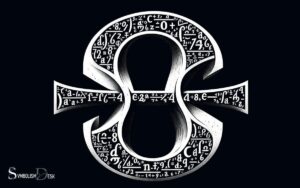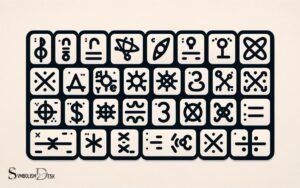Alt Codes for Math Symbols: Explain!
To insert math symbols using alt codes, hold down the Alt key and type the corresponding number on the numeric keypad. Release the Alt key to produce the symbol.
Alt codes allow you to type special characters that are not readily available on a standard keyboard. For mathematical symbols, these codes are especially useful in fields like education, engineering, and scientific research, where such notation is frequently required.
To use an Alt code, you need to ensure your Num Lock is on and you use the numeric keypad to enter the numbers.
Here’s a short example of Alt codes for common math symbols:
Utilize Alt codes to seamlessly integrate mathematical notation into your documents without the need for specialized software.

Key Takeaway
Understanding Alt Codes and Their Function
The use of alt codes provides a convenient method for typing special characters, including math symbols, by utilizing the numerical keypad.
Alt codes are a combination of the Alt key and a numeric code that, when entered, produces a specific character or symbol.
This functionality is particularly useful for individuals who frequently use mathematical symbols in their work, such as students, educators, and professionals in the fields of science, technology, engineering, and mathematics.
By understanding how to use alt codes, users can efficiently input a wide range of math symbols, such as π, √, ≤, ≥, and ±, without the need to search for them in character palettes or memorize complex keyboard shortcuts.
Mastering alt codes can significantly enhance the typing experience for those who regularly work with mathematical notation.
Accessing the Numeric Keypad for Alt Codes
To access the numeric keypad for alt codes, press and hold the Alt key while entering the numeric code using the numerical keypad on the right side of the keyboard.
When accessing the numeric keypad for alt codes:
- Ensure Num Lock is activated to enable the numerical keypad.
- Use the numerical keypad on the right side of the keyboard, not the numbers above the letters.
- Input the specific alt code for the desired math symbol using the numerical keypad while holding down the Alt key.
Understanding how to access the numeric keypad for alt codes is crucial for efficiently inputting various math symbols.
Inputting Basic Math Symbols With Alt Codes
Efficiently input basic math symbols using alt codes with precision and accuracy. Alt codes provide a convenient way to input essential math symbols directly from the keyboard.
To do this, ensure that the Num Lock key is activated, then hold down the Alt key and type the corresponding code on the numeric keypad.
For instance, the alt code for the multiplication symbol (×) is 0215. Similarly, the alt code for the division symbol (÷) is 0247.
By utilizing alt codes, users can seamlessly insert math symbols into documents, presentations, and other digital content without the need to search through character maps or memorize complex keyboard shortcuts.
This method streamlines the process of incorporating mathematical notation, enhancing productivity and document accuracy.
Utilizing Alt Codes for Common Mathematical Notations
One can effectively incorporate common mathematical notations by utilizing alt codes, streamlining the process of inputting essential symbols with precision and convenience.
Alt codes offer a simple and efficient way to input common mathematical notations, such as:
- Greek letters like α, β, and γ for representing various mathematical concepts.
- Arithmetic symbols like ÷, ×, and √ for performing mathematical operations.
- Common mathematical constants like π and e for accurate representation in equations.
Exploring Alt Codes for Fractions and Special Symbols
In this section, we will explore the Alt codes for fractions, which provide a convenient way to input fractional values in documents and digital platforms.
Additionally, we will discuss the Alt codes for special math symbols, offering an efficient method for incorporating these symbols into various mathematical and scientific contexts.
Fractions Alt Code Options
Exploring alt codes for fractions and special symbols provides a convenient way to input these characters in mathematical documents and communications.
When it comes to fractions, alt codes offer several options for easily inserting these symbols into your work:
- Alt + 0188: ¼
- Alt + 0189: ½
- Alt + 0190: ¾
These alt codes enable the seamless inclusion of fractions in various documents, saving time and effort in typing and formatting. By using these codes, you can ensure that mathematical expressions and equations are accurately represented.
Understanding these alt codes can greatly enhance the efficiency of working with mathematical content.
Special Math Symbols Alt Codes
The utilization of alt codes for special math symbols facilitates the seamless incorporation of unique characters into mathematical documents and communications.
Alt codes provide a convenient way to insert special math symbols such as ± (Alt + 241), ² (Alt + 253), ³ (Alt + 252), √ (Alt + 251), and ½ (Alt + 171) into various platforms including word processing documents, emails, and online forums.
These symbols are essential for expressing complex mathematical concepts, equations, and notations.
By using alt codes, individuals can enhance the clarity and precision of their mathematical communication.
Understanding and utilizing these alt codes for special math symbols can significantly improve the efficiency of creating and sharing mathematical content, catering to the needs of mathematicians, scientists, educators, and students alike. One way to make the use of alt codes even more efficient is by incorporating them into a toolbox installation guide, which can serve as a reference for anyone creating mathematical content. By having easy access to the alt codes for special math symbols, users can streamline their workflow and focus more on the content itself. This can ultimately enhance the overall communication and understanding of mathematical concepts in various educational and professional settings.
Incorporating Alt Codes for Greek Letters and Variables
Let’s now shift our focus to the incorporation of alt codes for Greek letters and variables, an essential aspect of typing mathematical expressions and equations.
Understanding how to input Greek characters and utilize variables in documents can greatly enhance the clarity and professionalism of mathematical content.
This discussion will provide practical insights into effectively incorporating these elements into written work.
Typing Greek Characters
When typing Greek characters, incorporating Alt codes for Greek letters and variables allows for precise representation in mathematical and scientific documents.
Using Alt codes provides a quick and efficient way to input Greek letters and mathematical symbols without the need for special software or copy-pasting.
This method is particularly useful for those who frequently work with mathematical equations or scientific notation, as it allows for seamless integration of Greek characters into their work.
Additionally, Alt codes provide a standardized way of representing Greek letters across different platforms and software, ensuring consistency and compatibility.
Overall, incorporating Alt codes for Greek letters and variables simplifies the process of typing Greek characters and enhances the accuracy and professionalism of mathematical and scientific documents.
Using Variables in Documents
Incorporating Alt codes for Greek letters and variables enhances precision and efficiency when using mathematical and scientific notation in documents.
By utilizing Alt codes, users can seamlessly insert Greek letters such as α (Alt code: 224) for alpha, β (Alt code: 225) for beta, and variables like x (Alt code: 120) and y (Alt code: 121) into their documents.
This method ensures that the correct symbols and variables are accurately represented, crucial for maintaining the integrity of mathematical and scientific content.
Moreover, Alt codes provide a quick and standardized way to input these characters, saving time and effort.
Understanding how to incorporate these codes for Greek letters and variables can significantly streamline the process of creating mathematically and scientifically accurate documents.
Inserting Equations and Operators Using Alt Codes
To input equations and operators using Alt codes, users can utilize a combination of keystrokes to insert mathematical symbols directly into their documents.
This method can be particularly useful for individuals who frequently work with mathematical equations and formulas.
By using Alt codes, users can efficiently insert a wide range of mathematical symbols without the need to switch between different software or use specialized tools.
Some popular Alt codes for equations and operators include:
- Alt + 43 for addition symbol (+)
- Alt + 45 for subtraction symbol (-)
- Alt + 47 for division symbol (/)
Tips for Efficiently Using Alt Codes for Math Symbols
An effective approach for efficiently using Alt codes for math symbols involves mastering the most commonly utilized codes for frequently occurring mathematical operators.
This can significantly enhance the speed and accuracy of inserting math symbols using Alt codes.
Below is a table of some commonly used Alt codes for math symbols to aid in efficient usage:
| Symbol | Alt Code | Description |
|---|---|---|
| Plus | Alt+43 | Addition operator |
| Minus | Alt+45 | Subtraction operator |
| Multiplication | Alt+0215 | Multiplication operator |
| Division | Alt+0247 | Division operator |
| Square root | Alt+251 | Square root symbol |
| Greater than or equal to | Alt+242 | Greater than or equal to symbol |
Conclusion
Alt codes provide a convenient and efficient way to input various math symbols, equations, and notations.
By accessing the numeric keypad and using specific combinations, users can easily incorporate a wide range of mathematical elements into their documents and equations.
With the vast array of symbols and characters available through alt codes, the possibilities for mathematical expression are virtually endless.






